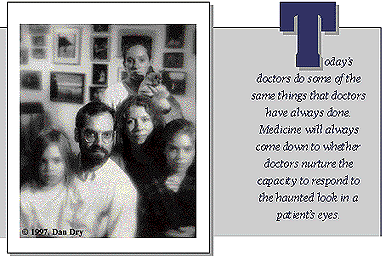
The University of Chicago Magazine
February 1997

Continued

U of C pediatricians John Lantos and Nancy Fritz with their daughters (clockwise from top): Hannah, holding Misty; Tess; and Emma
The new medical dramas on TV have lots of CPR. The shows get the feel of a resuscitation down just right--the tension, the frenzy, the primitive physical exertion of chest compressions, the crisp barking of cryptic orders: "Epi, stat, start a line, hang some dopamine, clamp that pumper!"
On television, most people survive. The script writers tease us with the possibility of failure, then gratify us with a Disney ending. In real life, survival rates after CPR range from 5 to 30 percent. Many survivors suffer neurologic damage and long-term disability. On three of the most popular medical dramas on TV, survival rates ranged from 60 to 100 percent, and none of the survivors suffered serious neurologic consequences. (See Diem, S; Lantos, J D; Tulsky, J.; "Outcomes after CPR on TV"; New England Journal of Medicine, 1996).
We don't seem to want to take our medical reality straight. In the part of ourselves that finds movies more interesting than medical journals, we don't believe that medicine is an orderly, straightforward endeavor. We believe in miracles and wonders.
These media-driven fantasies about CPR have made it the focus of a hard-fought moral debate over the question of whether doctors ought to offer treatments to patients even if the treatments are almost certain to be ineffective. The ethical debate--which began with a focus on CPR for terminally ill cancer patients or extremely premature newborns--has spawned voluminous literature and numerous legal cases. Like the film and television industries' inability to accurately portray dismal reality, it centers on the intermingling of hope, trust, rationality, and medicine.
The case-by-case debate about futility of treatment is part of a larger societal debate about allocating health-care resources. Do we want resources allocated to do the most good, or do we want to incorporate other, symbolic values? Is it okay to provide CPR when it won't work as a way of declaring our commitment to life, as a way of acting out our anger at death, or simply as an end-of-life ritual? Our views about such matters are shaped more by television's fictions than by medicine's realities. And our national inability to have a coherent discussion about health-care reform is, in many ways, as much a flight from reality as is our willingness to believe television's CPR survival rates.
Early in 1993, I was invited to participate in President Clinton's Health Reform Task Force as a member of the Working Group on Ethics. It was one of 30 such groups asked to analyze the health system and propose changes that might be incorporated into the bill the president was preparing to send to Congress. For months, we volunteers worked, trying to solve a vast and amorphous Rubik's Cube.
Every piece of the health-care puzzle was connected to every other piece. Fix Medicaid, or Medicare, or workman's compensation, and you'd screw up the financing of academic medical centers, or state mental-health care systems, or the private health-insurance industry. Health care is a trillion-dollar-per-year enterprise, one-seventh of the American economy, and entrenched interests, subcultures, and lobbyists were all sharpening their knives. At the eye of a storm so large and malevolent that nobody predicted its full fury, we worked peacefully in the quiet hallways and conference rooms of the Old Executive Office Building.
The process was as inspired and as chaotic as its brilliant and moody insomniac guru, Ira Magaziner. He had a set of procedures designed to allow all the groups to work simultaneously on different projects but that would create harmony, not dissonance. Each group was given weekly assignments, and, at week's end, we met in the Indian Treaty Room (we didn't realize then how prescient that choice of rooms would be). At the first meeting, the Ethics Working Group identified what we thought would be the major ethical challenges faced by any health-reform plan and suggested that the issue of rationing be formally addressed. Mr. Magaziner looked shocked. "There will be no rationing under the president's plan," he informed us. The process went downhill from there.
In late spring, as the storm clouds became more apparent, the working groups were dismissed. The president and first lady invited all 700 of us to a reception on the south lawn of the White House. The closing reception took place on a balmy spring evening. A military band on the balcony played jazz. Waiters, all of whom looked a little like Steven Seagal, served lemonade. When the First Couple arrived, Hillary thanked everyone for their hard work, and Bill told us that the work of the task force was just the beginning, that if we could pass a health-reform law, we could usher in a new era of social justice in America. As we left, they said, we should each pick up a small token of their appreciation.
At the exit gate, more military waiters passed out boxes of M & Ms, embossed with the presidential seal. M & Ms? Social justice? We had just been fired with a sugar-coated thank you. Unable to imagine where we were going, I tried to think about where we'd been.
Continue reading, "Life Support."
Go to:
- INVESTIGATIONS
- CHICAGO JOURNAL
- EVENTS
- LETTERS
- CHICAGOPHILE
- Feature story, "LIFE SUPPORT"
- Feature story, "Brushes with perfection"
- Feature story, "Opening Chapters"
- Feature story, "Astronomical Figures"
- CLASS NEWS
- DEATHS
- BOOKS BY ALUMNI
- IN THE CLUBS
Return to February 1997 Table of Contents